
http://www.iaeme.com/IJM/index.asp 162 editor@iaeme.com
International Journal of Management (IJM)
Volume 7, Issue 7, November–December 2016, pp.162–171, Article ID: IJM_07_07_017
Available online at
http://www.iaeme.com/ijm/issues.asp?JType=IJM&VType=7&IType=7
Journal Impact Factor (2016): 8.1920 (Calculated by GISI) www.jifactor.com
ISSN Print: 0976-6502 and ISSN Online: 0976-6510
© IAEME Publication
LABOUR ABSENTEEISM IN A TEXTILE UNIT AT
KOLHAPUR
Dr. V.S. Dhekale
Vivekanand College, Kolhapur, India
Dr. B.T. Bandgar
CSIBER, Kolhapur, India
ABSTRACT
The present study focuses on labour absenteeism in the textile unit located at Kolhapur, in
western Maharashtra. Researchers have taken efforts to identify the causes of labour absenteeism
and find out the solutions on this labour problem. The empirical data is collected with the help of
questionnaires administered to the respondents, discussions with the concerned officials and were
classified tabulated, and analysed with the help of statistical tools. At the end of the analysis,
researchers reached to the certain conclusions and have offered suggestions for mitigating the
problem of labour absenteeism, so that performance of the unit is not hampered due to this labour
problem.
Key words: Absenteeism, Features of Absenteeism, Measures to control absenteeism.
Cite this Article: Dr. V.S. Dhekale and Dr. B.T. Bandgar, Labour Absenteeism in a Textile Unit at
Kolhapur. International Journal of Management, 7(7), 2016, pp. 162–171.
http://www.iaeme.com/IJM/issues.asp?JType=IJM&VType=7&IType=7
1. INTRODUCTION
The labour bureau (1962) defines absenteeism as the percentage of total shifts lost against the total number
of man shifts scheduled to work. According to websites dictionary “absenteeism is the practice or habit of
being an absent and an absentee is one who habitually stays away from work. “Absenteeism” is the time
lost in industrial establishment by avoidable or unavoidable absence of employees. Absenteeism signifies
the absence of an employee from work when he is scheduled to present for the work. It is unauthorized,
unexplained, avoidable and wilful absence from work. The absenteeism is universal fact and it differs from
industry to industry, place to place, occupation to occupation.
2. DEFINITION OF ABSENTEEISM
Absenteeism refers to the absence of a worker when properly scheduled to work. According to Webster’s’
Dictionary, absenteeism is the practice of habit of being an ‘absentee’ and an absentee is one who
habitually stays away.

Labour Absenteeism in a Textile Unit at Kolhapur
http://www.iaeme.com/IJM/index.asp 163 editor@iaeme.com
3. THE ABSENTEEISM RATE
The formula recommended for by the United States Department of Labour for computing he absenteeism
rate at the end of each month is as follows- Absenteeism Rate= (No. of days of employees’ lost through
job absence during period ÷ Average No. of employees× No. of work days) × 100
4. EXTENT OF ABSENTEEISM
The rate of absenteeism varies from 7% to 30%. In some seasons of the year, it reaches up to 40%. The
rate of absenteeism varies from industry to industry, place to place, occupation to occupation. The reasons
for such absenteeism too are different.
In Madras, the rate of absenteeism increased from 8.9 percent in1951 to 16 percent in 1980. The
absenteeism rate has increased from 12.7 percent to 22 percent in Bombay, 8.3 percent to 14.9 percent in
Ahmadabad; and 12 percent to 24.8 percent in Kanpur.
In engineering industry, it increased from 13.9 percent to 19.1 percent in Maharashtra; in West Bengal
from 10.1 percent to 17.3 percent; and in Karnataka from 9.7 to 15.7 percent during the same period, the
percentage of absenteeism went up from 10.6 to 18.8 percent in Dhariwal (Mamoria and Gankar, 2009).
5. REVIEW OF LITERATURE
5.1. Absenteeism – A Brief Review in Cotton Textile Industry in India
The absenteeism in cotton textile mills in Mumbai varies from 19.5 percent to 25.3 percent. Absenteeism
in Solapur varies from 26.5 percent to 46.6 percent and the absenteeism rate at Ahmadabad varies from
13.6 percent to 14.6 percent and that of Karnataka, it varies from 17.8 percent to 24.1 percent.
The rate at Kanpur in cotton textile varies from 11.6 to 24.8 percent. The average absenteeism rate at
Mumbai is 22.4 %, at Solapur 36.5 %, at Ahmadabad 14.1 %, at Kanpur and Karnataka the rate is
20.9percent and 18.2 percent respectively.
5.2. M. Karthikeyan and Dr. P. Sivakami (2008)
Authors suggested that job repetition should be minimized, proper medical should be provided to the
employees, recreation facility should be improved in the organization, motivational training should be
given to the employees at regular period of time, skilled and semi-skilled labours should be treated as
same. Promotions should be given to the employees for their excellent performance.
5.3. S. Shanmuga Sundaram and N. Panchanatham (2011)
Authors analysed the manpower related export problems disturbing the export performance in Madras
Export processing zone, special economic zone and export oriented units at Madras. The study was of a
diagnostic nature. They suggested that, labour productivity can be improved by imparting knowledge and
skills to the workforce by arranging training programmes.
5.4. K. Vishnupriya, N.S. Suganya and P. Bhuvaneswari (2012)
The authors studied absenteeism among the Employees’ Of Textiles Industries; Coimbatore .The
relationship between management and workforce has to be sustained and employee’s problems should be
solved with proper solutions to avoid absenteeism. They suggest that the salary of the employees should
also be increased based on performance and experience. The safety measures that are adopted should be
improved by the company.

Dr. V.S. Dhekale and Dr. B.T. Bandgar
http://www.iaeme.com/IJM/index.asp 164 editor@iaeme.com
6. RATIONALE OF THE STUDY
Cotton textile industry in India is an oldest and largest industry. It has been observed that there is a high
rate of absenteeism among the respondents particularly in textile mills. Frequent absenteeism in industry
causes loss to respondents as well as industry. Hence, this topic was selected for the research.
Absenteeism means failure of a worker to report for work when he scheduled to work. Absenteeism is
unauthorized, avoidable and wilful absence from duty. Absenteeism is a universal problem in industry.
Therefore, it is necessary to study the causes of absenteeism and offer the measures to control absenteeism
so that loss of production can be controlled.
7. STATEMENT OF THE PROBLEM
On the backdrop of the above facts, study of absenteeism in a textile unit situated near Kolhapur (Western
Maharashtra) was selected for the present study. Hence the title of the study is - “Labour Absenteeism in a
Textile Unit at Kolhapur”. The identity of the unit is not disclosed just to protect its confidentiality.
8. SCOPE OF THE STUDY
The data collected for the present study pertains to the period from 2011-12 to 2115-16. The analytical
scope pertains to the calculations of responses to the each question and the percentages drawn on the
frequencies to the response. The analysis leads to know the causes of absenteeism and measures to control
the absenteeism.
9. OBJECTIVES OF THE STUDY
• To study the absenteeism rate in the organization under study for the past five years
• To trace out the reasons of absenteeism in the organization under study
• To know the opinions of the respondents about working conditions, remuneration, economic conditions,
family background, that contribute to the problem of absenteeism
• To suggest measures, if any, to reduce the rate of absenteeism.
10. RESEARCH METHODOLOGY
10.1. Research Design
It is a descriptive and exploratory study. The survey method is used to carry out the research.
10.2. Data Collection
For the research purpose, both primary and secondary data is used to complete the study.
Primary Data: Primary data were collected by administering the structured questionnaires to the
respondents.
Secondary Data: Secondary data were collected from reference books, published research papers,
magazines, and internet websites.
10.3. Tools for Data
Structured Questionnaire was used to collect the primary data for the present study.
The responses are collected through structured questionnaire relevant to the objectives of the present
study. The questionnaire structured in Yes- No form. The sub questions also were asked for more
clarification wherever necessary.

Labour Absenteeism in a Textile Unit at Kolhapur
http://www.iaeme.com/IJM/index.asp 165 editor@iaeme.com
10.4. Interview
Interview technique also used to gather the information from the managers and other officers in connection
with the objectives of the present study.
10.5. Observations
For the present study researcher has used the observation technique also wherever necessary.
Population Size: (N = 677)
The universe of sample consists of the total number of employees working in the organization under study.
The Sample Size: 140
The simple random sampling method is used to determine the sample size.
The sample size comprises of 20% of the employees on the roll.
Thus 677 X 20% = 135.40.
For the sake of convenience the sample size for present study is rounded to 140 respondents (n=140).
11. DATA ANALYSIS AND INTERPRETATION
The data collected through questionnaires, were classified, tabulated and percentages were calculated to
arrive at conclusion.
Table 1 Demographic Information of Respondents
Sr. No. Marital Status Frequency Percentage
1 Married 116 82.86
2 Unmarried 23 16.43
3 Widow 01 00.71
Total 140 100
AGE GROUP
Sr. No. Age group Frequency Percentage
1 20 to 25 years 17 12.14
2 16 to 30 years 29 20.71
3 31 to 35 years 23 16.43
4 36years and above 71 50.72
Total 140 100
LEVEL OF EDUCATION
Sr. No. Level of Education Frequency Percentage
1 Matriculation 66 47.14
2 Higher secondary 61 43.57
3 Graduation 13 09.29
Total 140 100
MONTHLY WAGES/SALARY
Sr. No. Monthly Wages/Salary Rs. Frequency Percentage
1 5000 to 7000 20 14.28
2 7001 to 10000 37 26.43
3 10001 and above 83 59.29
Total 140 100

Dr. V.S. Dhekale and Dr. B.T. Bandgar
http://www.iaeme.com/IJM/index.asp 166 editor@iaeme.com
NUMBER OF DEPENDENTS
Sr. No. Number of Dependents Frequency Percentage
1 Up to 3 18 12.85
2 4 to 6 97 69.29
3 7 and above 25 17.86
Total 140 100
NUMBER OF EARNING MEMBERS
Sr. No. Number of earning members Frequency Percentage
1 One 93 66.43
2 Two 30 21.43
3 Three and above 17 12.14
Total 140 100
INCOME FROM OTHER THAN WAGES/SALARY
Sr. No. Income from other than
wages/salary
Frequency Percentage
1 No other source of income 32 22.86
2
Source of income
(Agriculture source = 94
Other source = 14)
108
77.14
Total 140 100
The above Table 1 reveals that
(a). Marital Status of Respondents
That majority (82.86%) of respondents are married, and they have the families and have to shoulder the
family responsibilities.
(b). Age of Respondents
That 50.72% of respondents are above 36 years of the age, and 16.43 % are in the age group of 31 years to
35 years. Thus majority of respondents are above the age of 31 years.
(c). Education of Respondents
That education wise classification of the respondents shows 47.14% of the respondents are matriculate..
Respondents above higher secondary level are 52 .86% (43.57+9.29). Thus majority of respondents are
educated above the level of higher secondary level.
(d). Wages of Respondents
That the 59.29 percent respondents are getting monthly wages more than rs. 10000. It means about 60
percent that is majority of the respondents are getting better wages.
(e). Dependents of Respondents.
Those 69.29 percent respondents have 4 to 6 members in their family. That means about 70 percent
employees have the members as two children, spouse and two other dependents.
(f). Earning Members in Family
The 66.43 percent respondents are only the earning members in their family
(g). Respondents Earning other Income
The 77.14 percent respondents have other source of income. Further 64.14 % respondents have income
from other source (agriculture) and 10 percent respondents have income from other than agriculture
source.


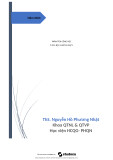

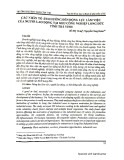
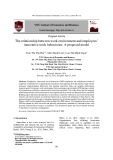


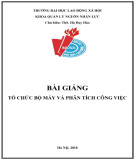
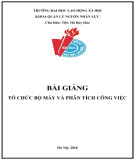

![20 câu hỏi Quản lý dự án phần mềm có đáp án [mới nhất]](https://cdn.tailieu.vn/images/document/thumbnail/2025/20251003/hieu2004haha@gmail.com/135x160/78791759734259.jpg)


![Tài liệu Quản lý dự án: Kiến thức nền tảng toàn diện [chuẩn SEO]](https://cdn.tailieu.vn/images/document/thumbnail/2025/20250910/kimphuong1001/135x160/92631757496585.jpg)











